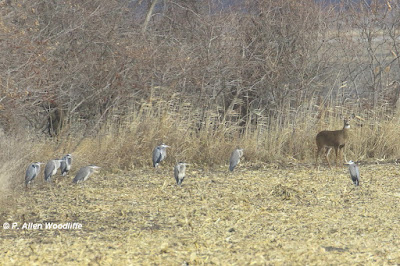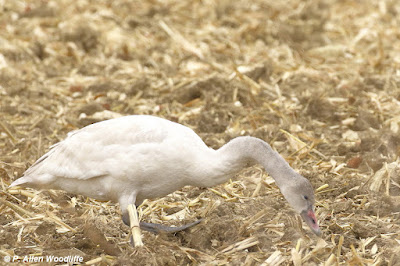Shorebirds are something you don't expect to find very often once December and sometimes freezing temperatures are the norm. But in the last week or so, a few species continue, and certainly a highlight was that of a Western Sandpiper.
The place to see this rarity, and others, was along the Erieau Marsh Trail. Unfortunately the trail wasn't always easy to access, as a large tree limb had come down on one of the windy days that occurred recently. I took note of it, along with this photo, and sent it to my municipal Chatham-Kent Trails staff contact. She indicated it would be cleared as soon as yesterday (Tuesday) afternoon, so hopefully by the time this post is sent out, the trail is clear for any hikers and cyclists who wish to use the trail.
The obstruction on the trail wasn't impossible to get through, although a bit of agility made it easier for hikers. For cyclists, that was another matter.
At any rate, getting past the fallen limb to the muddy edges of the wetland near the observation deck, was worth the effort. The shorebirds were not always in sight, as evidenced by various eBird posts indicating the shorebirds were not seen. But patience paid off, as it often does when birding, and after an hour or so, the shorebirds came into view along the more distant shore. A bit more patience paid off, as they eventually came a lot closer to the edge of a small channel that meandered through the mud flats. Even at that, a good telephoto lens and some significant cropping was required to get these.
Some observers may have initially thought of this bird as none other than a Semipalmated Sandpiper (SESA), and indeed, it does look similar. However a SESA is unheard of almost anywhere in North America at this late date, as they are far, far away on their wintering grounds. Western Sandpiper (WESA) is not common by any means, but there are a few records this late in the season even here in Ontario. I have seen them twice before, including on one of the local Christmas Bird Counts, where I had one at the south end of the Rondeau Marsh Trail even in later December!
A closer look at this individual shows some subtle, but definite, differences between SESA and WESA, as can be noted in the three photos shown here. In this individual, (a) the bill is a bit stouter, with a slight droop at the tip, (b) the bird seems a bit stockier, with almost no neck, and (c) a look at the crown shows some slight streaking. All of those features, as well as the lateness of the season, point quite strongly to WESA, and photos that were sent to shorebirds specialists for assistance agreed with this identification.
The WESA was often in accompaniment with 5-6 Dunlin, a slightly larger shorebird that is one of the most likely species to occur this late in the season. It also has a noticeable droop to the tip of the bill, but is overall quite a bit larger, and differs in its plumage pattern.
 |
| Dunlin |
Another shorebird species, a Lesser Yellowlegs, was seen near Shrewsbury this same day, but was gone by the time I passed by that spot.
With lots of water spots still at least partially open due to the slightly warming temperatures, other water birds remain in good numbers. I saw more than 30 Sandhill Cranes while on a drive through parts of the former Dover Twp. Some were at St. Clair NWA, as shown here, while others were at a wetland farther north.
Tundra Swans are pretty regular in parts of Chatham-Kent these days, especially if there are recently harvested corn fields with the stubble remaining. There are large flocks scattered in various fields near SCNWA, but even larger flocks are in fields north of Ridgetown. I believe it is partly because of the presence of the sewage lagoons where they sometimes rest for the night, but mainly because there are far more untilled fields with corn stubble still available for feeding. In Dover Twp, most harvested corn fields are already worked up, or at least have had the stalks cut smaller and have been baled to then be used as a covering for some vegetable crop to protect it from harsher winter weather.
A couple of days ago while driving north of Ridgetown, I came across several fields with swans, totaling well over 3000 birds. Along one quiet gravel road, the swans were quite close to the road. But as soon as I slowed up, the birds showed an immediate concern and at least started to head farther inland.
For some reason this first year bird, as evident by its continuing grayish neck and the pinkish bill, gleaning corn or whatever from the edge closest to the road, showed no concern. I was able to get several photos that were hardly cropped at all.
Sticking with a water bird theme, sort of, here is a photo of one of a couple of dozen American Tree Sparrows which, along with some Dark-eyed Juncos, a couple of Fox Sparrows and an American Goldfinch, was enjoying some of the puddles along Harrison Trail at Rondeau. Certainly not a true water bird, but...
The Eastern Screech Owl still shows up from time to time, peeking out of its cavity in the American Beech along Bennett Ave.
The woods are certainly quiet these days, an excellent time to enjoy the tranquility of the world of nature!
If you want to subscribe, or unsubscribe, to Nature Nuggets, send an email to: prairietramper@gmail.com















No comments:
Post a Comment